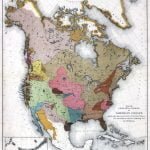
The map entitled “Linguistic Families of American Indians North of Mexico”, by J. W. Powell, issued by the Bureau of American Ethnology, Smithsonian Institution, some years ago and several times revised and reprinted, indicates the position of the various groups of tribes when they first became known to Europeans. The map, as its title implies, includes the entire North American continent north of Mexico, but in the present paper, only that portion bordering on the lower Mississippi, and eastward to the Atlantic coast, will be considered.
The principal stocks indicated on the map as having been encountered within this region during historic times, those with whom the early Spanish and French explorers came in contact during the sixteenth and seventeenth centuries, as well as others who entered the country or subsequently changed their position, are the Caddoan, Siouan, and Algonquian, west of the Mississippi, and the Muskhogean, Algonquian, Iroquoian, Timuquanan, and Siouan, together with a small group of Uchean, east of the river.
Although some of the native tribes may have been long established in the localities in which they were discovered, it is evident that movements of various separated groups had taken place during the generations immediately preceding their first contact with Europeans. It is likewise believed that sufficient evidence is now available, as a result of the investigation of many ancient sites, and a comparative study of the languages, customs. and traditions of the scattered tribes, to make it possible to trace, with a degree of certainty, the routes followed by the tribes during their migrations, and to discover some of the causes that may have impelled their removal into the regions which they- continued to occupy in historic times.
Four maps have been prepared to indicate the country occupied or traversed by the several groups during their migrations. The maps are presented not only in the endeavor to trace the possible routes followed by the tribes, but also in the attempt to ascertain the probable points of contact of the various groups and to reveal how tile movement of one must necessarily have affected the position of others.
In tracing the movements of the native peoples away from their earlier habitat, and later after they had become more widely dispersed, the linguistic families have been treated as units, with few specific references to any of the numerous tribes, often detached, of which each group was composed.
In determining the section of country claimed or occupied by the groups centuries ago, the conclusions have been reached by tracing hack from the present to the distant past, but in presenting the evidence, the opposite method has been adopted, and consequently the first map shows the probable position of the tribes during the earliest period now being considered. No attempt has been made to indicate, nor will it ever be possible to determine, the exact bounds of the regions dominated by the groups at a given time. The areas as shown on the maps are only approximated and consequently must not be considered as definite or positive, although their relative positions, based oil such information as is now available, are assumed to be very nearly correct.
The migratory movements of the tribes resulted in the crossing and re-crossing of some parts of the country by peoples who differed greatly in manners and customs, whose characteristic forms of burial, varied types of pottery vessels, and stone implements and weapons are now discovered intermingled on the same sites. However, tribes belonging to the same group often differed as greatly from one another as they did from tribes of other stocks. Thus, the material recovered from the numerous sites is often difficult or impossible to identify, but in the future, when additional mounds, burial places, and camp sites have been examined and the objects discovered have been studied and compared, new light will be shed on the early movements of the tribes, which will result in either the verification or refutation of certain theories about to be presented.
Obviously, many of the conclusions expressed in this brief sketch are hypothetical, but nevertheless it is believed that they are based on sufficient evidence to justify their presentation in this form in order to provide a basis for future research in the endeavor to determine, more clearly, the tribal movements east of the Mississippi in prehistoric times.
Tribal Migrations East of the Mississippi
- Linguistic Stocks During the Earliest Period Migrations
- Linguistic Groups at the beginning of the Sixteenth Century
- Iroquoian and Muskhogean Tribes after arrival East of the Mississippi
- Iroquoian Peoples resulted in the separation of the Siouan and Algonquian Tribes
